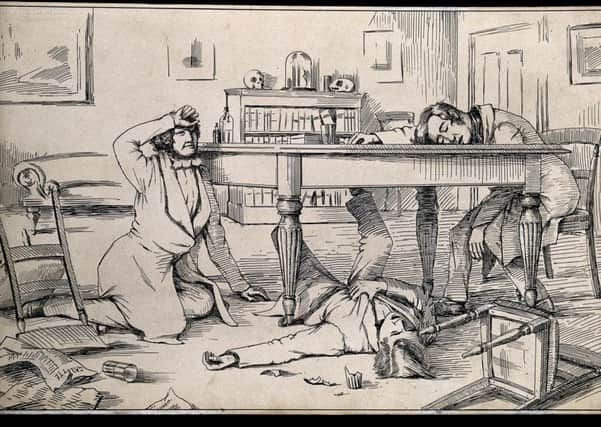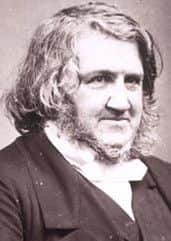The drug-induced Edinburgh dinner parties that revolutionised medicine


A fascinating insight into Sir James’ work by his daughter Eve Blantyre Simpson sheds light on the supper gatherings - first at his flat at Dean Terrace and then at 52 Queen Street - and the batch of narcotics that were on the menu.
Sir James had become fixated on finding a way to the ease of pain of surgery after being traumatised by the experience of one female patient during his time at Edinburgh University medical school.


Advertisement
Hide AdAdvertisement
Hide AdAfter briefly leaving medical school to take up law, he returned to medicine “devoted...to mitigate in some manner the dreadful agonies which were endured within the grim walls of the Royal Infirmary.”
It was his experiment with chloroform on November 4 1847 that was to directly lead to the liquid being inhaled in the operating theatre for the first time just two weeks later.
In her biography of her father, Eve Simpson recounts the early experiments amid a time “of great interest in Dean Terrace” where her father would fill his home with guests, eat luncheon, and “every evening have an anaesthetic seance.”
She added: “In company with Dr George Keith and Dr Mathews Duncan he there tried various compounds of a narcotic nature with a boldness not to be daunted that the experiments might cross the boundary of unconsciousness never to return.”


Tumblers, finger-glasses and saucers were among items distributed to participants with a teaspoon of substance placed in the vessel and warmed in hot water.
The “operators” would hold their mouth and nostrils over the vessel, with slow and deliberate inhalation to follow.
On one occasion, chloric ether in fizzy water “that looked like Champagne” was taken by a servant and given to a cook, who “after drinking it, hastily fell down.”
Advertisement
Hide AdAdvertisement
Hide AdA Professor Miller, in his account of the gatherings, told how he would return to the scene of the experiments at breakfast time the next morning to check that no one who had taken part had died.
It was Prof Miller who also gave a first-hand account of the November 4 experiment when the group took chloroform together for the first time. It has been argued that Sir James had earlier tried the drug alone in a vivisection lab.
Prof Miller recalled how, on the night, the group had inhaled several substances without much effect before it occurred to Sir James to try an “ponderous material which he had earlier set aside.”
He found the chloroform “from beneath a heap of waste paper” with tumblers charged.
The account said: “Immediately, an unwonted (sic) hilarity seized the party; they became bright eyed, very happy and very loquacious, expatiating on the delicious aroma of the new fluid.
“The conversation was of unusual intelligence, and quite charmed the listeners.
“But suddenly there was a talk of sounds being heard like those of a cotton mill, louder and louder; a moment more, than all was quiet, and then a crash.”
Advertisement
Hide AdAdvertisement
Hide Ad“On awakening, Dr Simpson’s first perception was mental.’This is far stronger and better than ether’ said he to himself.
“His second was to note that he was prostrate on the floor and that among the friends about him there was both confusion and alarm.”
It was noted that Dr Duncan’s jaw had dropped, his eyes were staring and that he was snoring in the “most determined and alarming manner”.
On December 3 1847, Sir James, in a letter to his daughter, wrote of the “odd occasion” of what he said was the first chloroform experiment.
He said: “Before sitting down to supper we all inhaled the fluid and “were under the mahogany in a trice.”
While chloroform had already been found in America and used in France and Germany, Dr Simpson is credited with discovering its anaesthetic properties through inhalation.
On November 15 1847, chloroform was used for the first time in surgery, with the assembled medica, including Professor Miller and Dr Duncan, “rejoicing” in the physiological effects of the substance.
Advertisement
Hide AdAdvertisement
Hide AdSir James, who graduated from Edinburgh University in 1832 and who later became Professor of Medicine and Midwifery at the age of 28, was appointed physician to Queen Victoria in Scotland the year of the great chloroform experiment.
Three years later was invited to become a member of the staff of the Edinburgh Royal Infirmary, a rare honour for an obstetrician at that time.
He was awarded the Order of St Olaf by the King of Sweden, the Monthyon prize of the French Academy of Medicine, and honorary doctorates by Oxford and Dublin.
Academies and medical societies from all over the world honoured him. In 1866 he was created a baronet, the first received by a doctor practicing in Scotland, and in 1869 he was granted the Freedom of the City of Edinburgh.
